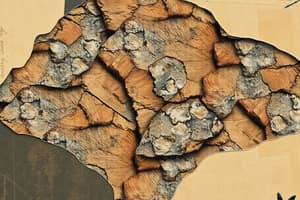Podcast
Questions and Answers
What is the primary agent involved in chemical weathering?
What is the primary agent involved in chemical weathering?
- Glacial movement
- Temperature
- Wind
- Water (correct)
Which process describes the breakdown of minerals in the presence of water under acidic conditions?
Which process describes the breakdown of minerals in the presence of water under acidic conditions?
- Compaction
- Oxidation
- Condensation
- Hydrolysis (correct)
In the dissolution process, what does carbonic acid primarily decompose?
In the dissolution process, what does carbonic acid primarily decompose?
- Carbonates (correct)
- Silicates
- Nitrates
- Oxides
Which of the following results from hydrolysis of orthoclase?
Which of the following results from hydrolysis of orthoclase?
What is the main outcome of the oxidation process in weathering?
What is the main outcome of the oxidation process in weathering?
Which factor does NOT influence the rate of weathering?
Which factor does NOT influence the rate of weathering?
How do stalagmites and stalactites form in caves?
How do stalagmites and stalactites form in caves?
During hydrolysis, how do hydrogen ions affect mineral structures?
During hydrolysis, how do hydrogen ions affect mineral structures?
Which statement accurately reflects the relationship between mineral stability and weathering rates?
Which statement accurately reflects the relationship between mineral stability and weathering rates?
What environmental factors most significantly influence weathering rates?
What environmental factors most significantly influence weathering rates?
Which of the following best describes the hydration mechanism in weathering?
Which of the following best describes the hydration mechanism in weathering?
What is a key characteristic of dissolution processes in weathering?
What is a key characteristic of dissolution processes in weathering?
In oxidation reactions during weathering, which mineral undergoes transformation to form iron oxides?
In oxidation reactions during weathering, which mineral undergoes transformation to form iron oxides?
What effect does the presence of carbonic acid have on olivine?
What effect does the presence of carbonic acid have on olivine?
Which mineral undergoes hydration to form gypsum?
Which mineral undergoes hydration to form gypsum?
In which climate does chemical weathering occur most intensively?
In which climate does chemical weathering occur most intensively?
What is one major influence on the rate of weathering related to the rock itself?
What is one major influence on the rate of weathering related to the rock itself?
What happens to weathering rates in the presence of soil?
What happens to weathering rates in the presence of soil?
How does oxygen influence the oxidation process of dissolved iron?
How does oxygen influence the oxidation process of dissolved iron?
What characteristic of heavily fractured rocks affects their weathering rate?
What characteristic of heavily fractured rocks affects their weathering rate?
What is one outcome of increased time of exposure to weathering processes?
What is one outcome of increased time of exposure to weathering processes?
What is produced as a result of the reaction between dissolved iron and oxygen in the presence of water?
What is produced as a result of the reaction between dissolved iron and oxygen in the presence of water?
Which factor is NOT typically associated with the process of hydration in minerals?
Which factor is NOT typically associated with the process of hydration in minerals?
What is the primary mineral that contributes to the formation of bauxite, the main source of aluminum?
What is the primary mineral that contributes to the formation of bauxite, the main source of aluminum?
Which type of weathering involves the physical breaking of rock into smaller fragments without altering its chemical composition?
Which type of weathering involves the physical breaking of rock into smaller fragments without altering its chemical composition?
What is a key characteristic of frost wedging in the context of mechanical weathering?
What is a key characteristic of frost wedging in the context of mechanical weathering?
Which of the following types of weathering is primarily caused by the evaporation of water containing dissolved salts?
Which of the following types of weathering is primarily caused by the evaporation of water containing dissolved salts?
What process is described as the peeling away of concentric shells of rock due to water infiltration?
What process is described as the peeling away of concentric shells of rock due to water infiltration?
Which mechanism is NOT associated with mechanical weathering?
Which mechanism is NOT associated with mechanical weathering?
What environmental condition makes frost wedging particularly effective?
What environmental condition makes frost wedging particularly effective?
Which type of mechanical weathering involves the growth of tree roots in rock cracks?
Which type of mechanical weathering involves the growth of tree roots in rock cracks?
In mechanical weathering, which process leads to the formation of slabs in rocks?
In mechanical weathering, which process leads to the formation of slabs in rocks?
What is true about the volume of rock fragments during mechanical weathering?
What is true about the volume of rock fragments during mechanical weathering?
Which of the following factors is the primary contributor to the nutrient richness of soil?
Which of the following factors is the primary contributor to the nutrient richness of soil?
In which climate do soils show the most extensive leaching of nutrients?
In which climate do soils show the most extensive leaching of nutrients?
What is most likely to occur if there is poor drainage in soil?
What is most likely to occur if there is poor drainage in soil?
How does time influence soil formation?
How does time influence soil formation?
Which factor does NOT significantly influence the rate of weathering?
Which factor does NOT significantly influence the rate of weathering?
What kind of soil is expected in humid temperate regions?
What kind of soil is expected in humid temperate regions?
Which component in the soil aids chemical weathering by producing organic acids?
Which component in the soil aids chemical weathering by producing organic acids?
Which of the following best characterizes the impact of topography on soil formation?
Which of the following best characterizes the impact of topography on soil formation?
What mainly results from the decay of plant material in soil?
What mainly results from the decay of plant material in soil?
What is a distinctive characteristic of Aridisols?
What is a distinctive characteristic of Aridisols?
Flashcards are hidden until you start studying
Study Notes
Chemical Weathering
- Breakdown of rocks by chemical decay of their minerals, resulting in the formation of new minerals stable at the Earth's surface
- Water is the most important agent involved
- Most important processes are:
- Hydrolysis: Decomposition reaction with water under acidic conditions. Carbon dioxide from air or bacterial decay of vegetation forms carbonic acid, which then ionizes and replaces metallic cations in mineral crystal structures
- Dissolution: Acidic conditions aid in the dissolution of minerals, particularly carbonates. Carbonic acid reacts with calcite to form calcium and bicarbonate ions
- Oxidation: Chemical reaction where an atom or molecule loses electrons. Oxygen dissolved in water is the most common oxidizing agent, where it oxidizes iron in ferromagnesian silicates
- Hydration: Absorption of water into the crystal structure, potentially disrupting the rock's structure
Factors Affecting Chemical Weathering
- Climate: Moisture and heat promote chemical reactions. Chemical weathering is intense in humid, tropical environments and slow in polar regions and deserts.
- Mineral Composition: The rate of chemical weathering is related to the stability of the minerals in the rock.
- Time: The longer a rock or mineral is exposed to weathering, the more weathering takes place.
- Rock Structure: Heavily fractured or jointed rocks weather faster than massive rocks.
- Presence of Soil: Weathering and soil formation have a positive feedback loop. Soil formation increases rock weathering, leading to more soil formation.
- Slope: Weathering residues are chemically stable.
Soil Formation
- Parent Material: The bedrock or sediment from which the soil forms. Influences the type and nutrient richness of a soil.
- Topography: Influences the availability of water and the rate of soil accumulation. Soils are thinner with an increase in slope gradient, as water and weathered material migrate downslope.
- Vegetation: Contributes organic matter (OM) to the soil, produces CO2 and O2 for chemical weathering, and releases organic acids that enhance weathering. The root system of plants protects soil from erosion.
- Drainage: Type of soil strongly depends on the height of the groundwater table. A high groundwater table results in poorly drained soils, which are saturated with water and may have a high content of OM.
- Time: The longer the time, the thicker the soil produced.
- Climate: Precipitation and temperature influence soil formation by affecting the rate of weathering and plant growth. Soil formation is most rapid in warm, moist climates.
Different Soil Types
- Tropical and subtropical regions: Soils are deeply weathered and have a low OM content.
- Arid Regions: Limited plant growth, low OM content, and salt precipitation.
- Humid Temperate Regions: Soils are relatively clay-rich and organic-rich.
- Cool to Temperate, Swampy Regions: OM-dominated soils.
Soils of Tropical, Humid Climates: Laterite (Oxisol)
- Lacks a B horizon due to extensive leaching of Ca, Na, K, Mg, and SiO2 during decomposition of silicate minerals.
- Primarily composed of Fe & Al oxides, quartz, kaolinite, and organic matter.
- In some regions, Fe and Al oxides concentrate to form ore deposits.
- Bauxite: Al ore with Al2O3 > 30%
Soils of Arid & Semi-arid Climates: Aridisol
- Low content of organic matter (OM).
Weathering
- The combined process of chemical weathering (decomposition) and mechanical weathering (disintegration) of rocks and minerals at the Earth's surface.
Mechanical Weathering
- Physical forces break rocks into smaller fragments without changing their mineralogical and chemical composition.
- Increases the surface area of the fragments while the volume remains constant.
Types of Mechanical Weathering
- Ice (Frost) Wedging: Alternate freezing and thawing of water in fractures and cracks promotes disintegration of rocks. Water expands when it freezes, exerting pressure that can break rocks. Effective in cold climates and mountainous regions with frequent freeze/thaw cycles.
- Salt Crystallization: Water containing dissolved salts penetrates cracks. Upon evaporation, salt crystal growth creates pressure that fractures rocks. Effective in coastal areas and desert regions where rising groundwater evaporates.
- Sheeting: Fracturing into slabs parallel to the rock surface due to a decrease in overburden pressure from erosion.
- Spheroidal Weathering: The peeling away of concentric shells of decayed rock. Caused by water seeping into fractures and promoting chemical weathering.
- Thermal Expansion: Short-term heating of a rock mass causes the margin to expand, creating differential stresses that cause the exterior to peel off. Effective during forest fires and in areas with large daily temperature variations.
- Abrasion: Mechanical wearing of rock surfaces by friction and impact of particles moving in a flow of water, wind, or ice. Fresh rock weathers faster than weathered rock.
- Biologically Induced Mechanical Weathering: Roots of trees can grow into cracks and wedge them open.
Fate of Weathering Products
- Material in Solution: Na, K, Mg, Ca ions are taken up by plants, absorbed by groundwater, or transported by fluvial runoff (into lakes, seas, forming biochemical and chemical sediments).
- Residual Material: Clay minerals and Fe-oxides remain at the site of weathering, becoming part of the weathering profile, or are eroded and transported by fluvial, aeolian, and other processes.
Mechanical vs Chemical Weathering
- Interrelated processes: Chemical weathering opens channels for water to penetrate the rock, which aids fragmentation, while fragmentation speeds up chemical decay by increasing rock surface area.
Weathering Rates
- Dependent on:
- Lithology: (chemical & mineralogical composition)
- Climate: (temperature, precipitation, vegetation)
Studying That Suits You
Use AI to generate personalized quizzes and flashcards to suit your learning preferences.




